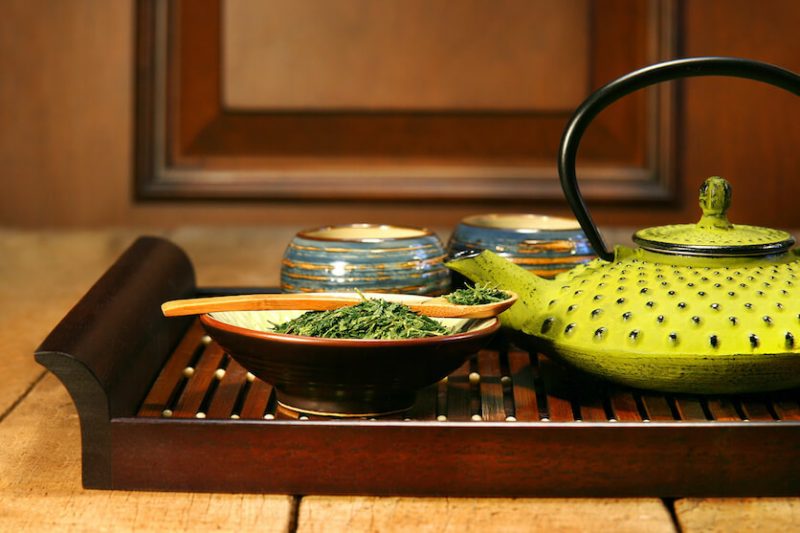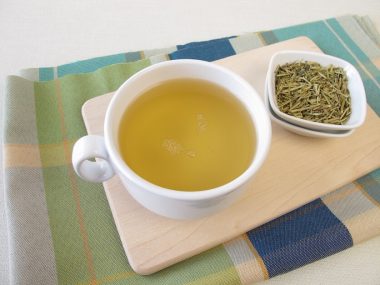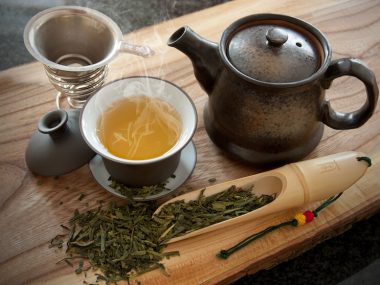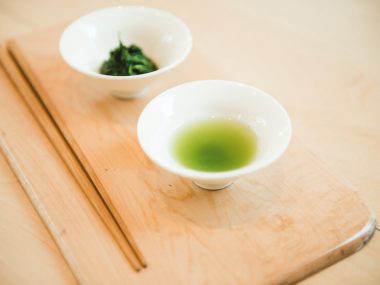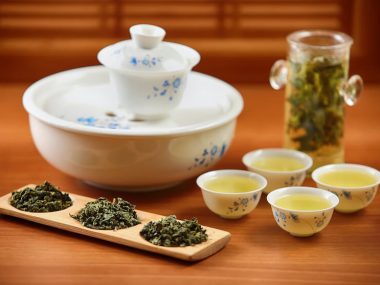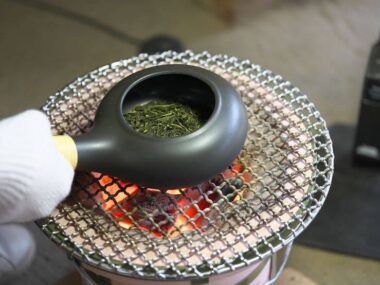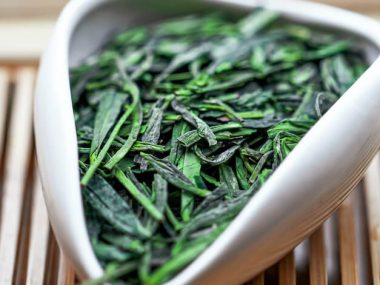Did you know a certain Japanese green tea constituent inhibits the stimulatory effect of caffeine and doubles as a nice afternoon snack? Nope, in that case, you’d be thrilled to find out how and why Gyokuro is “top shelf!”
Table of Contents
What Is Gyokuro Tea?
Gyokuro is a green tea made from Camellia sinensis (tea plant). What sets this green tea apart from others is where it’s grown, how it’s cultivated, and processed. In fact, the unique cultivation process makes this green tea is a highly sought-after tea by those living in Asia and tea connoisseurs around the world.
Where Does Gyokuro Green Tea Come From?
Gyokuro green tea is the highest grade of Japanese green tea. Tea drinkers are more than willing to dole out the extra dollars to enjoy it. So, what makes this tea the best in Japan? It’s unique cultivation and processing methods.
Gyokuro is a higher grade green tea due to the way it is grown, harvested, and processed. Unlike other green teas picked throughout the harvest season, Gyokuro is harvested once. Tea plants that have been dormant during the winter begin to sprout new tea leaves in spring. The tender new sprouts are harvested to make Gyokuro green tea. This very limited harvest of brand new tea leaves is why this green tea fetches a higher price.
Common Japanese Green Teas
To better understand how Gyokuro is cultivated and processed, we’ll take a look at Japanese green teas and where Gyokuro falls within those teas.
In Japan, green tea growers either grow tea plants in full sun. Or prior to harvest, they will shade the tea plants. According to the tea they are going to make, shading and harvests (flushes) are timed at specific times to produce certain flavors and qualities in a green tea.
Gyokuro (highest-quality tea)
Gyokuro green tea is made from the first tea leaf sprouts. The tea plant has overwintered and is more nutrient-dense and sweet.
- Most expensive
- Grows in 0.3% sun
- Shaded 20 days before harvest
- Flavors include umami, mellow, sweet
- Higher in amino acids (theanine)
Sencha (high-quality tea)
Sencha tea is steamed green tea of top-shelf quality too, grown primarily in Shizuoka, Fukamushi, and Kagoshima provinces of Japan.
- Most common/consumed green tea in Japan
- Grows in 70% full sun
- Harvested earlier than other green teas
- Flavors include sweet, slightly astringent
- Higher in amino acids (theanine)
Matcha (high-quality tea)
Matcha tea is made of powdered leaves of green tea variety called tencha — tea plants, grown specifically to make the best matcha.
- Shaded 20 days prior to harvest
- Post-processing with pulverizing/grinding dried tencha into a fine powder
- Flavors include umami, sweet, vegetal
Genmaicha
Genmaicha is another variation of Japanese tea, made from lower-grade tea leaves with roasted rice incorporated into it post-harvesting.
- Post-processing to incorporate roasted rice
- Made from sencha, bancha, or Gyokuro
- May be dusted with matcha to add vibrant color and sweetness
- Savory flavor of nuttiness
- Low in caffeine compared to other green teas
Hojicha (low-grade tea)
Some tea lovers may be surprised to know that Hojicha tea is made from leftover scraps of the tea.
- Post-processing with roasting over a charcoal fire
- Made from coarse leftovers/stems of sencha or bancha
- Flavors include toasty and smoky
Kukicha (low-grade tea)
Similar to Hojicha this tea variety is also made of scraps, mainly leftover stems/twigs of sencha or Gyokuro.
- Flavors include mild, creamy, and nutty
- Low in caffeine compared to other green teas
Bancha (lowest-grade tea)
Bancha is considered to be the lowest-grade green tea variety since it’s made from the lower leaves/stems of sencha.
- Harvested later in the year
- Flavors include slight bitterness, sweet, nutty
- Teas such as genmaicha and hojicha are made from bancha
Shading Tea Plants
Tea growers shade certain tea plants intended for a specific tea. For example, to make the highest-grade green tea (Gyokuro), tea growers roll out long shade screens to cover the tea plants 20 days before harvest. Doing so helps develop a unique taste of this tea.
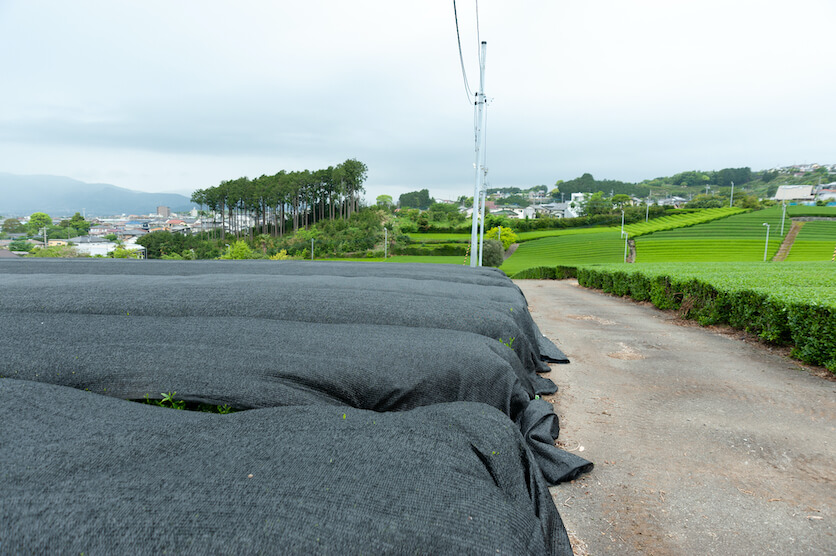
After winter, tea plants for Gyokuro are just sprouting young tender leaves (the first since winter). These tender sprouts are shaded for several weeks before harvest to cause the leaves to produce more chlorophyll. With the absence of the full sun, more chlorophyll is necessary to keep the tea plant alive. This excess of chlorophyll makes the tea leaves more vibrant in color, softer, and very sweet.
Without the presence of the full sun, these tea plants draw up nutrients from underground. These nutrients are otherwise absent in tea plants that go unshaded.
Gyokuro vs. Sencha: What are The Differences?
Gyokuro is a higher quality grade of Japanese green tea. When comparing it to sencha, there are a few things that set each one apart.
| Gyokuro | Sencha |
| Theanine level: Higher | Theanine level: Lower |
| Caffeine level: Higher | Caffeine level: Slightly Lower |
Types: 1
| Types: 4
|
Harvest (Flush)
| Harvest (Flush)
|
Processing Method
| Processing Method
|
| Shading: 20 days before harvest | Shading: Varies |
Flavor
| Flavor
|
What Does Gyokuro Taste Like?
Gyokuro tea drinkers claim this tea to have various tastes that range from bitter, umami to sweet and buttery. However, a published research article entitled “L-Theanine Boosts Alpha Waves, Promotes Alert Relaxation” reports Gyokuro as having a “5th taste.”
“5th taste” is what’s known as “umami.” Umami is a taste sensory picked up by our tongue, detecting a savory, brothy, protein-like taste. The International Glutamate Information Service explains how umami and our perceptions of taste are intertwined.
The taste buds on our tongue are the receptors that tell our brain what something tastes like. It has always been believed that those taste buds pick up four basic tastes; sweet, sour, bitter, and salty. However, in 2000, scientists discovered a fifth taste receptor on the tongue. This receptor detects umami.
Going back to the previously mentioned research article introducing the “5th taste,” Gyokuro not only tastes umami, but it also has a tea constituent (L-Theanine) that reduces the bitterness and stimulating effect of caffeine. The fifth taste of umami and the presence of L-Theanine act together, telling us a cup of Gyokuro is, in fact, delicious.
Can You Eat Gyokuro Leaves?
Surprisingly, many people use Gyokuro leaves for cooking with and for eating as a snack after brewing tea with them. Saveur Magazine has a recipe on how to make a lovely snack with your spent Gyokuro tea leaves. Cook the tea leaves in vinegar, soy sauce, and sesame oil and add them to rice with a garnish of sesame seeds.
How Much Caffeine Is In Gyokuro Tea?
Some green teas contain more caffeine than others. Tea processed from the first harvest (flush) have higher levels of caffeine than those harvested later. Green tea made from bancha is lower in caffeine.
Higher caffeine: Gyokuro, tencha, matcha, sencha (1st flush)
- Young, leaf sprouts/buds
- 1st flush (harvest)
- Shaded tea plants
Lower caffeine: genmaicha, hojicha, karigane, kukicha, and sencha (later harvests)
- Older leaves, stems, twigs
- Later flushes
- Unshaded tea plants
A six-ounce cup of Gyokuro yields about 92 mg of caffeine.
Is It Okay To Drink Gyokuro Tea Every Day?
Gyokuro is definitely on the higher end of the caffeine scale. Should you choose to drink it, moderation is a must to avoid caffeine jitters and rapid heartbeat. If you happen to have a medical condition, are taking medications, have allergies, or are sensitive to caffeine, it’s best to talk to your doctor to find out if Gyokuro is safe to enjoy.
What Is Gyokuro Tea Good For?
Green tea is known for its numerous health benefits. Those benefits may vary between each variety. Cultivation and processing greatly influence the type and amount of benefits a green tea provides. Gyokuro unique processing method lends some unique Gyokuro green tea health benefits.
The Alternative & Complementary Therapies Journal article mentions Gyokuro green tea as having high levels of L-theanine (an amino acid). In fact, the contents of this substance is the highest among other green teas.
Reported benefits from L-theanine:
- Better focus
- Better sleep
- Relaxed state without drowsiness
- Better cognition
- Immune booster
- Reduces high blood pressure
The article also mentions that 30-40 minutes after consuming Gyokuro, a sense of relaxation sets in. This relaxation does not sedate or affect the central nervous system, nor is it a sleep aid.
Side Effects Of Gyokuro Tea
The FDA (Food and Drug Administration) lists L-Theanine as “generally safe.” So you should not worry much about your daily intake, as long as you stay within under 3 cups a day.
However, Memorial Sloan Kettering Cancer Center notes that over-consumption of green tea may cause digestive upset, nausea, difficulty getting to sleep, or jitters.
How To Brew Gyokuro
Gyokuro is an expensive green tea, so the last thing you want to do is incorrectly brew it ruining the overall quality, benefits, and flavor. Because the Japanese use spent Gyokuro tea leaves to cook with or eat as a snack, the question arises, “How many times can you steep Gyokuro?” This tea can be brewed multiple times.
Ingredients:
- 2 teaspoons of loose-leaf Gyokuro tea
- 2 cups of water
Directions:
- Heat the water to 140 degrees (F.)
- Remove from the heat.
- Place the loose-leaf tea into a tea infuser.
- Drop the tea infuser into the hot water.
- Cover, and allow to steep for 5 minutes
- Remove the cover and the tea infuser.
- Pour the tea into a teacup and enjoy!
Gyokuro: A Must-Try Green Tea
Gyokuro green tea has unusual origins and a highly peculiar taste. It just might be the green tea that lures you over to the “other side” of your senses and presently tingles your taste buds with its robust palette of flavors.
